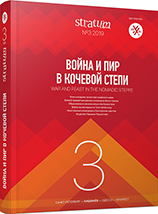Формирование раннескифского культурного комплекса Келермесского могильника в Закубанье
The Formation of the Early Scythian Cultural Complex of the Kelermes Burial Ground in Trans-Kuban
Author(s): Tatyana V. RyabkovaSubject(s): History, Archaeology, Cultural history, Ancient World
Published by: Издательский дом Stratum, Университет «Высшая антропологическая школа»
Keywords: Trans-Kuban region; ancient Scythian period; Kelermes burial mound; Veselovsky mounds; Schultz mounds; cultural complex;chronology;
Summary/Abstract: This article is devoted to an overview of groups of artefacts that were found in mounds in the Kelermes burial mound. A second exploration of Kelermes in the 1980s established the sequence of construction of the mounds, and this, along with changes in the collections of artefacts, makes it possible to trace the stages of the formation of the early Scythian cultural complex. The sequence of development can be traced on the basis of materials from the older Kelermes mounds, including mounds 1 and 2 excavated by Nikolay Veselovsky and mound 4 excavated by David Schultz: intensive peaceful contacts with Transcaucasia, characteristic of a population which had migrated from Central Asia at the time of Veselovsky’s mounds, ceased abruptly in the period of Schultz’s mound no. 4, which looks like a sort of ‘return to the sources’. Materials from mound 3 from Schultz’s excavations demonstrate the extent of cultural interaction with the peoples of Western Asia, Anatolia and Transcaucasia. At that time the fledgling nomadic culture was being enriched by the achievements of the Eastern-Greek world. The ‘royal’ class of artefacts from this complex show the unusually high social status of the deceased, comparable with that of an Assyrian king. There are numerous analogies of the materials from mound 24 in other mounds from the Ancient Scythian period, so it is possible to synchronize it with these monuments. Mound 24, one of the latest in the burial mound, appeared at a time when there was not yet any Greek pottery in Trans-Kuban, despite the fact that links with the Eastern-Greek world already existed. Finds from the 1st Razmenny (Kostromsky) mound and the settlement of Tarasova Balka are evidence of the large-scale import of ancient pottery into Trans-Kuban in the last quarter of the 7th century BC.The changes observed in the inventories from the Kelermes burial mound show the length of time the cemetery was in use, the incorrectness of applying the dates of monuments with ancient pottery to all its mounds and the impossibility of dating the burial mound to a narrow timeframe.
Journal: Stratum plus. Археология и культурная антропология
- Issue Year: 2019
- Issue No: 3
- Page Range: 319-338
- Page Count: 20
- Language: Russian
- Content File-PDF

